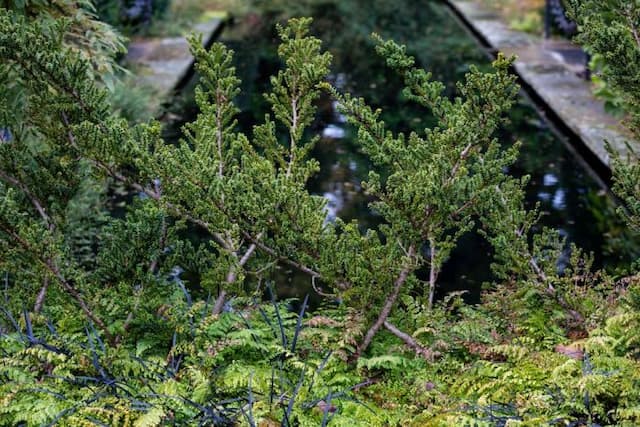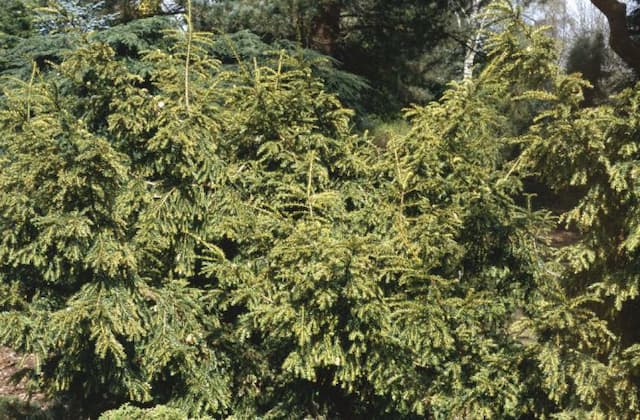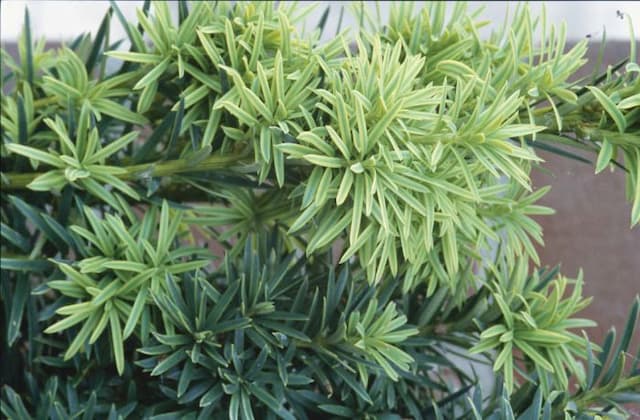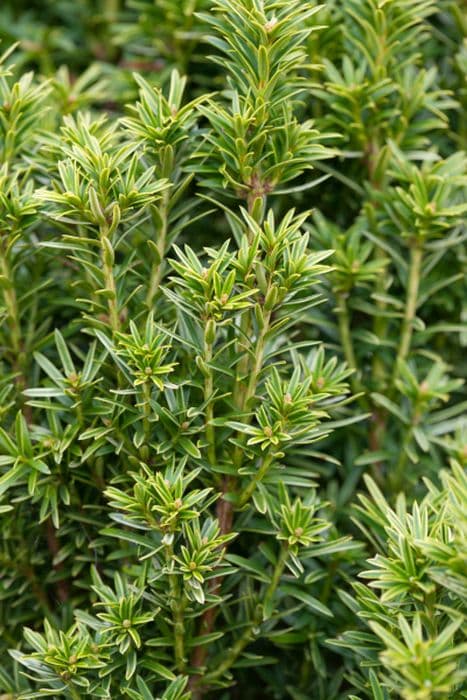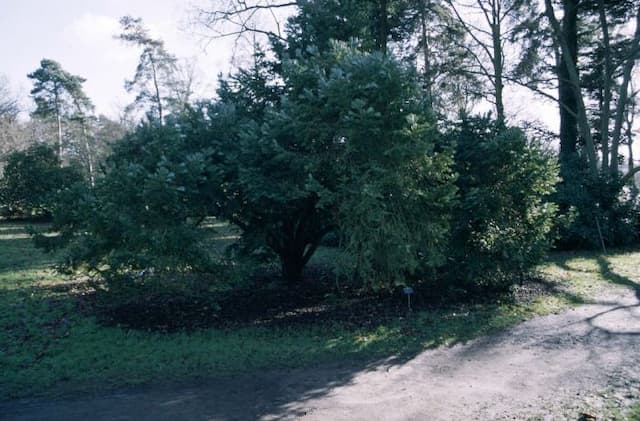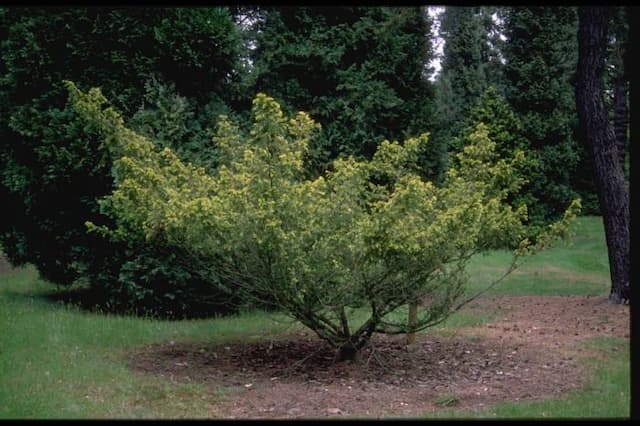Irish Yew Taxus baccata 'Fastigiata' (f)

ABOUT
Taxus baccata 'Fastigiata', commonly known as the Irish Yew, is a coniferous plant with a distinct, upright growth habit. It has dense branches that give it a sleek and columnar appearance. The needles of the Irish Yew are dark green, small, and arranged spirally on the twigs, but they appear as two flattened rows on either side due to the twisting of the leaf base. This provides a lush, textured look throughout the year as the foliage is evergreen, maintaining their color even during the colder months. The Irish Yew produces conspicuous red berries, technically called arils, which are a distinguishing feature among yews. Only female plants bear these bright, showy fruits which open at the end to reveal a single, hard seed. These arils emerge in late summer and add a splash of color to the Irish Yew's foliage. The bark on the trunk and branches is thin and scaly, typically presenting in shades of gray or brown. Its unique, narrow vertical form and rich foliage make it a popular choice for ornamental purposes in various landscapes, as it provides both visual interest and can serve as a hedge or privacy screen without taking up much horizontal space.
About this plant
 Names
NamesSynonyms
Irish Yew, Upright Yew, Fastigiate Yew
Common names
Taxus baccata 'Fastigiata'.
 Toxicity
ToxicityTo humans
The English Yew is highly toxic to humans. All parts of the plant, except the fleshy aril surrounding the seed, contain potent cardiotoxic alkaloids such as taxine. If ingested, symptoms of poisoning can include dizziness, dry mouth, dilation of the pupils, weakness, heart problems, and potentially fatal respiratory failure. Ingesting even a small amount can be dangerous, and immediate medical attention is needed in the event of ingestion.
To pets
The English Yew is also poisonous to pets. Like in humans, all parts of the plant contain toxic compounds, particularly taxine alkaloids, which can interfere with cardiac function. Symptoms of yew poisoning in pets can include vomiting, difficulty breathing, tremors, seizures, and heart failure, which can be fatal. Any ingestion of the plant by pets warrants immediate veterinary attention.
 Characteristics
CharacteristicsLife cycle
Perennials
Foliage type
Evergreen
Color of leaves
Green
Height
10-15 feet (3-4.5 meters)
Spread
2-3 feet (0.6-0.9 meters)
Plant type
Tree
Hardiness zones
6-7
Native area
Europe
Benefits
 General Benefits
General Benefits- Ornamental Appeal: The Irish Yew's dense, dark green, needle-like foliage and columnar shape add architectural interest to landscapes.
- Low Maintenance: Once established, it requires minimal care, making it a convenient choice for gardeners.
- Drought Tolerance: It can survive periods of low rainfall, thus reducing the need for frequent watering.
- Wildlife Habitat: The dense branches provide shelter and nesting sites for birds.
- Longevity: The Irish Yew is known for its long lifespan, providing a long-term presence in gardens or landscapes.
- Privacy Screen: It can be used as a hedge or privacy screen due to its dense growth habit.
- Year-Round Interest: As an evergreen, it provides color and structure throughout all seasons.
 Medical Properties
Medical Properties- Source of paclitaxel (Taxol): Paclitaxel is a chemotherapy drug used to treat various forms of cancer, including ovarian, breast, lung, and pancreatic cancers. It is originally derived from the bark of the Pacific yew tree (Taxus brevifolia), but Taxus baccata can also produce it.
 Air-purifying Qualities
Air-purifying QualitiesThis plant is not specifically known for air purifying qualities.
 Other Uses
Other Uses- Architectural Focal Point: Due to its narrow, upright growth, the English Yew 'Fastigiata' serves as a striking architectural plant in gardens, creating visual interest and contrast against rounder, bushier plants.
- Hedging: English Yew 'Fastigiata' is often used to form elegant, dense hedges for privacy screens that require regular trimming to maintain the desired shape.
- Topiary: This plant is suitable for topiary work because of its dense foliage and ability to recover well from pruning, allowing gardeners to shape it into various forms.
- Bonsai: With its slow growth and manageable size, English Yew 'Fastigiata' can be cultivated as a bonsai, allowing enthusiasts to create miniature landscapes.
- Woodworking: English Yew 'Fastigiata' provides a hard and durable wood that can be used for making furniture or woodworking crafts, although it should be noted that the wood is toxic if ingested.
- Bow Making: Historically, English Yew 'Fastigiata' wood was valued for making longbows, owing to its flexibility and strength.
- Wildlife Shelter: The dense foliage of this yew can provide valuable shelter for birds and small mammals in the garden.
- Religious Symbolism: The English Yew 'Fastigiata' has been historically planted in churchyards throughout Europe and is often associated with symbolism relating to everlasting life and resurrection.
- Maze Creation: Its ability to be trimmed to precise shapes and boundaries makes English Yew 'Fastigiata' a good choice for creating garden labyrinths or mazes.
- Garden Sculpture: When pruned into non-traditional shapes, English Yew 'Fastigiata' can serve as a living sculpture, providing year-round green art in a landscape.
Interesting Facts
 Feng Shui
Feng ShuiThe English Yew is not used in Feng Shui practice.
 Zodiac Sign Compitability
Zodiac Sign CompitabilityThe English Yew is not used in astrology practice.
 Plant Symbolism
Plant Symbolism- Eternal Life: Taxus baccata, commonly known as the English Yew, is often associated with eternal life due to its longevity and evergreen nature, symbolizing immortality and the continuity of life.
- Resurrection and Rebirth: The capability of yew trees to regenerate by sending new shoots from old trunks has linked them with resurrection and rebirth.
- Transition and Change: As a tree that has the ability to live through different ages and survive harsh conditions, the English Yew can represent the concept of transition and enduring change.
- Protection: Since ancient times, yew trees have been planted in sacred places such as graveyards, suggesting a symbolism of protection for the spirits of the deceased.
- Sorrow and Death: While the English Yew stands for long life, it can also embody sorrow and death, being a common presence in cemeteries across Europe.
 Water
WaterThe Irish Yew should be watered thoroughly, ensuring that the soil is moist but not waterlogged. In the first growing season, water the plant once a week with about 1.5 gallons of water to establish a strong root system. After establishment, the watering frequency should be reduced, and the plant should only be watered when the top few inches of soil are dry to the touch. During extended periods of drought, additional water may be required, but always check the soil moisture first. Overwatering can lead to root rot, so be cautious not to let the plant sit in standing water.
 Light
LightThe Irish Yew flourishes best in full sun to partial shade conditions. It is versatile and can also tolerate quite shaded areas, making it a flexible choice for various garden spots. The ideal location would receive sunlight for at least part of the day but would be protected from the harsh afternoon sun, which might scorch the foliage in excessively hot climates.
 Temperature
TemperatureIrish Yews are hardy and can handle a range of temperatures; they do best in temperatures between 60°F and 70°F but can survive in temperatures as low as -30°F. They are well-adapted to the cooler climates and can endure frost. It is important to shelter the plants from strong, cold winds which could cause drying and browning of the foliage.
 Pruning
PruningPruning the Irish Yew should be done to maintain the desired shape and density and to remove any dead or diseased branches. It is best pruned in late winter or early spring before the start of the new growth cycle. Light trimming can also be done throughout the growing season to keep the shape tidy. Avoid heavy pruning as the Yew may not recover well from severe cuts.
 Cleaning
CleaningAs needed
 Soil
SoilIrish Yew (Taxus baccata 'Fastigiata') thrives best in moist, well-drained soil that is slightly acidic to neutral, with an optimal pH range of 6.0 to 7.0. A soil mix consisting of loam, peat, and sand or perlite in equal parts can ensure proper drainage and aeration.
 Repotting
RepottingIrish Yew typically doesn't require frequent repotting and can be done every 3 to 5 years. It's important to replace the soil and check the root health during repotting.
 Humidity & Misting
Humidity & MistingIrish Yew favours outdoor conditions where natural humidity levels are typically adequate. It does not have special humidity requirements when grown in a garden setting.
 Suitable locations
Suitable locationsIndoor
Provide bright, indirect light and keep away from heat sources.
Outdoor
Plant in partial to full sun with good soil drainage.
Hardiness zone
6-7 USDA
 Life cycle
Life cycleTaxus baccata 'Fastigiata', commonly known as the Irish Yew, begins its life cycle with seed germination, which can be slow and irregular, often taking up to 18 months; the seeds require a period of cold stratification to break dormancy. Once germinated, the seedling grows incrementally each year, developing into a young plant with a characteristic upright, columnar habit. It enters a long juvenile phase, during which it may not produce reproductive structures, instead focusing on vegetative growth, forming dense, dark green foliage that is toxic if ingested. After several years, the Irish Yew matures and becomes capable of reproduction, typically through the development of small, inconspicuous male cones and bright red arils that contain the seeds, provided the individual is female as it is a dioecious species. These seeds, after dispersal, are often consumed and then excreted by birds, which aids in their distribution. The Irish Yew can live for hundreds of years, slowly reaching heights of up to 10-20 meters, and continues to produce seeds annually, concluding its life cycle upon death, at which point it may leave behind offspring to continue the population.
 Propogation
PropogationPropogation time
Late summer
Taxus baccata 'Fastigiata', commonly known as the Irish Yew, is often propagated by semi-hardwood cuttings. This method is most successful when carried out in late summer to early fall. Cuttings of about 6 to 8 inches (15-20 cm) are taken from current season's growth, ensuring a few sets of leaves remain on the stem. The lower leaves are removed, and the cut end of the cutting is dipped in a rooting hormone to encourage root development. The prepared cuttings are then placed in a well-draining potting mix within a propagation bed or tray that can maintain consistent moisture and warmth. A plastic cover or mist system is used to retain humidity around the cuttings. Roots typically develop within a few weeks to months, depending on environmental conditions.
